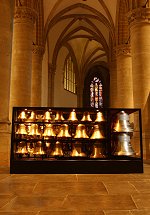
DORDRECHT - In 2003 Royal Petit & Fritsen Bell-foundry in Aarle-Rixtel was commissioned by Boudewijn Zwart to build a special travelling carillon. This 'Concert Carillon' comprises of 50 bells (range c2 - d2 - chromatic to - d6) with a standard profile and tuned in equal temperament (a1 = 440 Hz). All bells were given decorative edgings and moulding wires. The total weight of the bells is about 2,000 kg. A b-flat1 and c#2 bell were not included in the carillon because of the extra weight involved.
PRE-HISTORY
Combined playing of a tower carillon with other instruments is generally troublesome. When brass instruments or large percussion forces are used in a tower the sound does not need to be amplified, but other instruments usually will not be heard without amplification. Furthermore, recitals on a tower carillon can, in fact, only be listened to in the open air.
Although it is sometimes possible to make the carillon audible in a church or concert hall through audio equipment, it is certainly not an optimal situation. That way the idea arose for the design of a new type of travelling carillon: one with a traditional carillon keyboard and cast bronze bells that can be used anywhere, inside as well as outside.
WEIGHT
The scheme was to transport the Concert Carillon on a standard trailer assembly, pulled by a powerful car. The advantage of that is that the carillonneur can relocate the instrument himself, thus saving the costs involved with a rental truck and driver.
Were the usual steel profile to be used, the total weight of the frame would be as high as the overall weight of the bells, and the plan would not be feasible. An aluminium frame appeared to be too costly, because a) aluminium is difficult to weld and b) because for a sufficiently strong construction a larger volume of material would be needed compared with steel, having negative impact on the overall appearance of the instrument.
Ultimately a frame was made of steel tubular profiles. Based on accurate construction calculations the places were determined that needed heavier or lighter supporting beams. Thus the overall weight of the frame could be reduced by more than one-half, to about 700 kg.
CONSTRUCTION
To make it possible to move the instrument to any location, the carillon was made up out of three modular parts, each with a height of 145 cm. The length and width of the individual parts differ. Each section can pass through a door 80 cm wide and stands on four rubber swivelling wheels.
The first part is set square with the other parts and contains the four heaviest bells. To reduce the frame height, these four bells are not hung in the usual way, but are mounted on stands. The second part contains the keyboard, bells #5-8 and the transmission components for bells #1-8. The third part contains bells #9-50 and their transmission assemblies. All parts are held together with a set of simple clips.
KEYBOARD
The keyboard is built into the frame. The measurements are based on the existing North-European standard and the clavier keys are hinged in the centre. So, in fact, the keyboard is positioned above the bells.
Unlike normal keyboards, a 'linear' keyboard was designed for the Concert Carillon, with elevated 'black' manual keys, as is generally common for pedal keys. The big advantage is that the keys can be placed in a row. Synthetic wire adjusters can now easily be fastened to the keys with a butterfly nut. Every wire adjuster is connected to the transmission with a cable.
To reduce weight, pedal couplings are made of bicycle brake cables (copied from the practice keyboard). The keyboard radiates simplicity through its uncomplicated construction, free from annoying background noises.
SOUND
The sound volume of the carillon is amply sufficient. There are several options to reduce the volume when playing together with chamber music instruments. Most effective are the sheets of a special type of glass that can be easily fixed around the frame. Because all bells are in easy reach, it is also possible to apply tape on the clapper strike points, thus obtaining a more gentle, rounded sound.
From May 2-6 2003, the carillon was played for the first time during performances of the oratorio Saul by Georg F. Händel by the Stuttgarter Kammerorchest directed by Frieder Bernius as part of the 'RUHRtriennale' in Dortmund, Bochum and Wuppertal (Germany). From May 29-June 15 2003, the instrument could be listened to daily during the 'Dresdner Musikfestpiele'. The official Dutch premiere took place on Wednesday, August 20 2003, during the opening of the 'Grachtenfestival' in Amsterdam, where former Dutch Prime Minister Wim Kok unveiled the carillon to the public.
